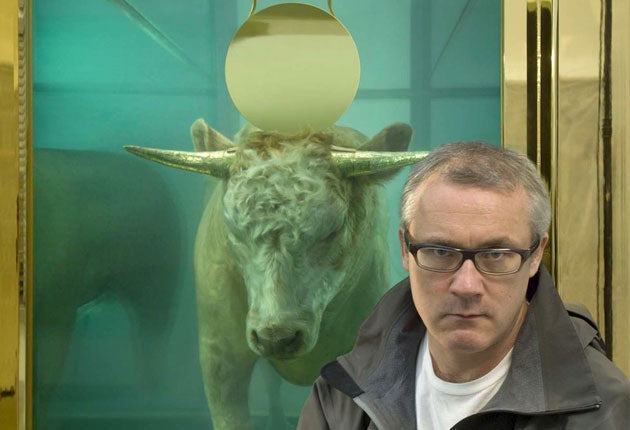Damien Hirst has famously said that art is only worth what someone will pay for it – which in the case of his creations always seems to be a ludicrously high amount of money. He is a hugely divisive figure – collectors see his art as an investment, yet critics have questioned the value of pieces such as The Golden Calf, a calf in a tank of formaldehyde which last year sold for £10.3m in a record breaking two-day auction at Sothebys.
Of course, the amount people are willing to pay for art directly relates to the artist themselves. (Funnily enough, if anyone else tries to sell a shark in chemicals – as the Stuckist movement did last year – it’s not nearly as popular.) Take the annual RCA postcard sale where well-known artists contribute work anonymously. Do you choose a postcard with a design you don’t like because you think it might be by a big name artist and therefore worth a lot more money than the £40 you paid for it? Or do you just go for what you like? And what happens when art is free, such as when street artist Adam Neate did an art drop in London last year, leaving 1000 pieces of art at locations around the capital. Is its value less or more to those who found it because they didn’t have to pay?
Continuing the debate and aiming to test Hirst’s sentiment, next month AUGUST art gallery is carrying out an experiment, entitled On CDOs and Double Clubs, on how we decide the value of art. It is part of this year’s East Festival of culture in London, and anyone can show work in the exhibition from 5 to 12 March (artists won’t have to go through the usual gallery validation process) and then choose whether to take part in the art swap on |10 March.
The idea is that those submitting a piece of art have to put their own value on it and swap it for another piece they consider to be worth an equal amount or more. The experiment – which is just as much about what artists (or viewers who are submitting pieces of art that they have previously bought) would pay for their own work as it is about what they would consider paying for others – highlights the difference between personal value and the amount of money something is worth. An artist might value a painting because they’ve spent hours perfecting the colour of the sky until it’s exactly the right shade of cobalt blue, but that doesn’t necessarily determine a high price.
Hirst’s point isn’t just relevant to the art world either. If you think that a new just-in parka in Topshop is so fabulous that it’s worth £55, you’ll pay that money. If you think a house that’s for sale isn’t worth the £150,000 asking price, you’ll only offer £130,000. And it’s the same when it comes to art. Someone else – in the art world the galleries or auction houses – sets out the guidelines and then it’s up to you if you agree that their valuation is accurate.
Monetary value and personal value are two very different things and, with no help or advice being offered from the gallery during AUGUST art’s experiment, it will be interesting to see if those taking part in the art swap think with their heads or their hearts.
After all, Damien Hirst might think his own art is great, but whether he would honestly price it in the same way as a paying punter is another matter.
Subscribe to Independent Premium to bookmark this article
Want to bookmark your favourite articles and stories to read or reference later? Start your Independent Premium subscription today.


Join our commenting forum
Join thought-provoking conversations, follow other Independent readers and see their replies